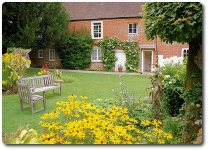Austen, Jane Contents
Later life
Settled at Chawton
In 1809, four years after Jane Austen’s father had died, Jane, Cassandra and Mrs. Austen moved into Chawton Cottage, in the rural  village of Chawton in Hampshire. The cottage was provided by her brother Edward and was only twelve miles away from their former home in Steventon. With the return to Hampshire came the return to routines that Jane seemed to thrive on and almost immediately she resumed the revision of Pride and Prejudice and Sense and Sensibility.
village of Chawton in Hampshire. The cottage was provided by her brother Edward and was only twelve miles away from their former home in Steventon. With the return to Hampshire came the return to routines that Jane seemed to thrive on and almost immediately she resumed the revision of Pride and Prejudice and Sense and Sensibility.
Mature novelist
In 1811, she began to write Mansfield Park, with Emma following in 1814 and Persuasion the year after that. These three later books are known as her mature novels. They continue to demonstrate Austen’s insight into the issues of morality, wealth and class. They also showcase her finesse with witty dialogue underlain with layers of meaning. In these mature novels, Jane Austen introduces new thematic elements and treatments of character:
- Mansfield Park is Jane Austen’s only overtly religious novel. Unlike the heroines of Austen’s previous novels, Fanny Price is a timid girl whose outer shyness belies an inward strength which enables her to remain true to her principles
- Persuasion introduces another reticent heroine, Anne Elliot. At 27, she is the oldest of Austen’s heroines. Her journey through rejecting - and then accepting - Captain Wentworth’s proposal of marriage explores the theme of second chances
- Emma is the only heroine in Jane Austen’s novels who does not need to marry for financial security. She is one of Austen’s most beloved heroines despite her meddlesome matchmaking and high opinion of herself.
Published novelist
During her career as a writer, two unsuccessful attempts were made to have her novels published:
- In 1797, Jane’s father sent the manuscript of First Impressions (later Pride and Prejudice) to Cadell and Davis, but it was declined without ever being read by them
- In 1803, Jane’s brother Henry sold Susan (later Northanger Abbey) to Crosby and Company for ten pounds, but it was never published.
Success came in 1811, with the publication of Sense and Sensibility. It can be difficult to keep track of when Jane Austen’s novels were written and published. This is partly because long periods of time elapsed between her extensive re-workings of them, and they were not published in the order in which they were written. To add to the confusion, only two of them were published under the titles Jane Austen originally gave them:
- Sense and Sensibility was begun in 1795 and was originally titled Elinor and Marianne. It was published in 1811
- Pride and Prejudice was begun in 1796 and was originally titled First Impressions. It was published in 1813
- Northanger Abbey was begun in 1796 and was originally titled Susan, then Catherine. It was published posthumously in 1817
- Mansfield Park was begun in 1811 and published in 1814
- Emma was begun in 1814 and was published in 1815
- Persuasion was begun in 1815. Its original title was probably The Elliots. It was published posthumously in 1817.
Reception as an author
Both Sense and Sensibility and Pride and Prejudice received favourable reviews.jpg) and were soon sold out. Mansfield Park sold out quickly too, but its reception was much quieter, perhaps because of current political turmoil. Sir Walter Scott reviewed Emma and extolled her use of realism and narrative control. Because of her anonymous publication of these novels, Jane Austen’s fame during her lifetime was limited, but she was asked by the Prince Regent to dedicate Emma to him.
and were soon sold out. Mansfield Park sold out quickly too, but its reception was much quieter, perhaps because of current political turmoil. Sir Walter Scott reviewed Emma and extolled her use of realism and narrative control. Because of her anonymous publication of these novels, Jane Austen’s fame during her lifetime was limited, but she was asked by the Prince Regent to dedicate Emma to him.
Sickness and death
In 1916, Jane Austen’s health began to decline. For a while she experienced a general malaise which developed into a fever. Most biographers believe that she was suffering from Addison’s disease. In January 1817 she was able to begin a new novel, called Sanditon, but was not able to finish it. In May she moved to Winchester for better medical care. She died on July 18, 1817. Due to her family’s connection with the Church of England, she was buried in Winchester Cathedral.
Dear Aunt Jane…
Both Henry Austen’s brief Biographical Notice of the Author, and James Edward Austen-Leigh’s memoir of his aunt, present Jane Austen as a traditionally sweet, modest and unambitious woman who lived a quiet and uneventful life. Her writings, letters and anecdotes from family members paint a fuller picture of her. Most of Jane’s letters were either burned or censored in the interests of her privacy. Those that remain add to our understanding of her:
- She had a biting sense of humour which she sometimes directed rather unkindly at the foibles of friends and neighbours
- She had sense of pride in her own sharp wit, intelligence and humour
- She had a desire to be published and make money from her writing
- She was a knowledgeable and accomplished woman who felt comfortable commenting on many topics including geography, medicine, music and literature.
